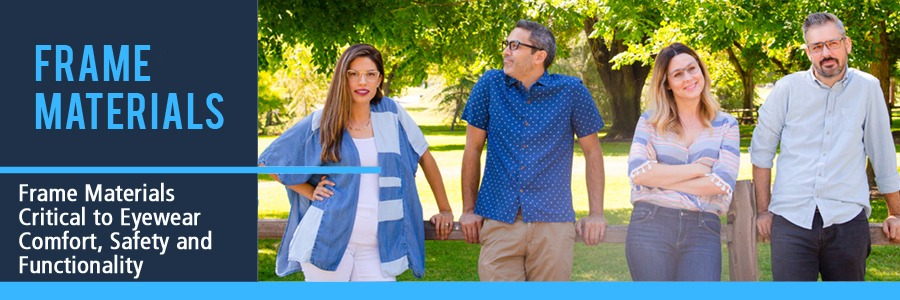
Personalized Eyewear Consultation by Appointment Only (215) 443-7706
- Home
- About
- Products
- Services
- Lens Lab
- Vision Care
- Newsletter
- Contact Us
Menu- Home
- About
- » Doug Wohl
- » Awards
- » Reviews
- Products
- » Bifocals
- » Computer Glasses
- » » Computer Vision Syndrome - Digital Eye Strain
- » Contact Lenses
- » » Are Contacts Right For You
- » » Guidelines for Contacts Wear and Care
- » » Instructions for Soft Contacts
- » Eyeglass Frames
- » » Frame Guide - Frame Shape and Face Shape
- » » Frame Materials
- » » Eyewear Maintenance
- » » Makeup Tips When Wearing Glasses
- » » Wiley X Eyewear Frames
- » Children Eyeglasses
- » » Eyewear for Babies and Young Children 0-5 Years Old
- » » Kids Corner
- » » 10 Tips for Buying Glasses for Children
- » Occupational Eyeglasses
- » Prescription Lenses
- » » Lens Coatings and Tints
- » » » Anti Reflective Coating
- » » Replacement Lens Options
- » Progressives
- » Readers
- » Safety Glasses
- » » Eye Injuries that Could be Prevented with Safety Glasses
- » » Prescription Safety Eye Glass Feature Guide
- » Single Vision Eyeglasses
- » Sports Eyewear
- » Sunglasses
- » » UV Eye Safety
- Services
- » Eye and Vision Exam
- » » Eye and Vision Problems
- » » Glaucoma Test
- » » Vision Refraction
- » Contact Lens Exam and Fitting
- » Eyeglass Repair
- Lens Lab
- Vision Care
- » Cornea
- » Detached Retina
- » Diabetic Retinopathy
- » Dry Eyes
- » Eye and Vision Conditions
- » Fun Eye Facts
- » Eye Function and Parts Explained
- » FAQ
- » Macular Degeneration
- » Makeup Causing Eye Damage
- » Medication Side Effects to Vision
- » Optic Nerve Damage
- » Optical Terms and Definitions
- » Red Eye
- » Retina Damage
- Newsletter
- » Blue Light Blocker Glasses
- » Buying Glasses Online
- » Covid-19 Safety Practices
- Contact Us
Frame Materials are Critical to Comfort, Safety and Functionality of your Glasses
Choosing a frame material that suits your purpose is critical as it plays a huge role in the comfort, safety and functionality of your glasses. Different materials lend themselves to different functions, price ranges and styles, and with each comes distinct advantages and disadvantages.
- Metal
- Metal is one commonly used material in the manufacturing of eyeglass frames due to its malleability, corrosion resistance, and ease of adjustability, making it very easy to tailor to many face shapes and frame styles. Metal frames typically tend to be more expensive, less durable and are not ideal for action sports. They hold their shape well, yet careful handling is still necessary to avoid bending. Metal frames are usually made of Monel (a metal alloy containing 2/3 nickel and 1/3 copper) that is corrosion resistant and sturdy; however, aluminum, titanium, stainless steel, cobalt, nickel silver (German Silver), and phosphor bronze are popular, also. Metal frames can be made of colored metal, or be color coated; giving color options beyond base metal colors. For people allergic to certain metals (typically nickel), choose a hypoallergenic option such as titanium or stainless steel, if you're set on wearing a metal frame.
- Nylon
- Nylon frames should be your go-to for sports and performance activities. Nylon frames are very resistant to temperature fluctuations, and remain super flexible while still retaining the stiffness required for safety. Nylon frames tend to be less expensive, lightweight and stronger than traditional metal frames. Virtually unbreakable. nylon glass frames are lightweight and flexible, but frames are limited to opaque colors.
- Titanium
- Generally found in higher-end glasses, Titanium frames are durable, scratch resistant, strong, lightweight, flexible, and rust-resistant. It is difficult to color, so titanium frames come in a limited range of colors. These frames are great for an active lifestyle, or those who require thicker lenses. Titanium is an awesome metal that many designer frames are made of; however, it can also be expensive.
- Polycarbonate
- This versatile, tough plastic offers serious impact resistance and can be found in many sport and safety glasses. Despite their durability, they tend to be rigid frames and are not very flexible. If you have children, a polycarbonate frame is a good choice for them as the frames can take a beating.
- Acetate
- Acetate is a plastic itself, but it is a little different. Compared to a standard plastic frame (usually Acrylic or Polyurethane), Acetate frames are stronger, more flexible and generally lighter. Acetate frames can come in a huge variety of colors and textures, and since the color is imbedded in the material itself instead of painted on, the color tends to stay.
- Plastic
- Glasses can be made out of a wide variety of plastic frames, from acrylic to polyurethane. Plastic frames are generally the cheapest frames available and can be a great option if price is an issue. Plastic frames are popular because of the vast assortment of colors, textures, patterns, and qualities available. Plastics vary, making plastic frames suitable for a variety of lifestyles and activities, like sports. ZYL or cellulose acetate is the most common type plastic used for frames because of its versatility. It is a composite of wood flakes, cottonseed fibers, stabilizers and plasticizers. ZYL can be damaged by ultraviolet radiation, perspiration, body oil and cosmetics, yet is still the plastic of choice.
Plastic frames typically do not bend the way metal fames can; however, they can become brittle and discolor with age or excessive heat, so buying a quality plastic is important, especially if you plan on wearing them for a long time.
About Wohl Optics Vision Care
Proper eyewear prescription AND fit are vital for your best vision. Fit is something that you will never get right with an online optical business. Veteran owned and operated - best in Bucks County Optical eye care shop.
How could your vision be better? What situations do you feel give you trouble when wearing eyeglasses? That is why we are here.
Exclusive Discounts
Military, Veterans, First Responders, Police, Firefighters, Ambulance all receive exclusive discounts (not combined with insurance or other discounts).
We accept most major Vision Insurance Plans.
(215) 443-7706 Phone
(215) 443-8795 FaxWohl Optics
550 Street Rd.
Warminster, PA 18974Veteran Helping Veterans - Local Bucks County, PA Independent Optician

Copyright © 2016-2022
All Rights ReservedCredit Cards Accepted

Private Consultations for your Family: Flexible hours at your convenience by appointment ONLY
Wohl Optics Regular Schedule:
Monday 10:00AM - 5:00PM Tuesday 10:00AM - 4:00PM Wednesday 10:30AM - 6:00PM Thursday 10:30AM - 7:30PM Friday 10:00AM - 6:00PM Saturday 10:00AM - 1:00PM We are offering personal appointments to everyone for the selection of eyeglasses and eyeglass adjustments. We will make every effort to accommodate your schedule. Let us know if you would like to meet at Wohl Optics outside of the above regular scheduled hours.
Service Areas
Bucks County, PA; Montgomery County, PA; Chester County, PA; Philadelphia, PA; Warminster, PA; Ivyland, PA; Warrington, PA;Furlong, PA; Warrington, PA; New Hope, PA; Southampton, PA; Bensalem, PA; Northampton, PA; Hatboro, PA; Willow Grove, PA; Huntingdon Valley, PA; Horsham, PA; Lansdale, PA; Montgomeryville, PA; Newtown, PA; Langhorne, PA; Lahaska, PA; Buckingham, PA; Yardley, PA; Chalfont, PA; Richboro, PA; Doylestown, PA; Glenside, PA; Ambler, PA; Fort Washington, PA; Churchville, PA; Norristown, PA; Washington Crossing, PA; Philadelphia, PA.
Wohl Optics 550 Street Rd. Warminster, PA 18974 (215) 443-7706 Privacy Policy HIPAA Sitemap
